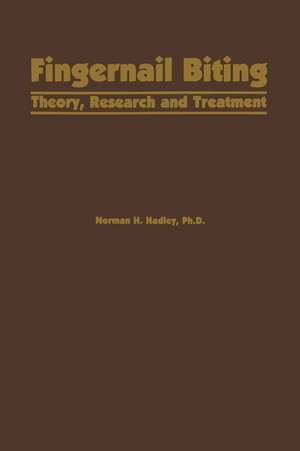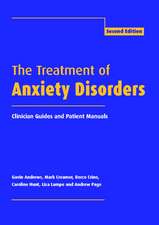Fingernail Biting: Theory, Research and Treatment
Autor N.H. Hadleyen Limba Engleză Paperback – 13 feb 2012
Preț: 362.51 lei
Preț vechi: 381.59 lei
-5% Nou
Puncte Express: 544
Preț estimativ în valută:
69.37€ • 72.61$ • 57.73£
69.37€ • 72.61$ • 57.73£
Carte tipărită la comandă
Livrare economică 31 martie-14 aprilie
Preluare comenzi: 021 569.72.76
Specificații
ISBN-13: 9789401163255
ISBN-10: 9401163251
Pagini: 192
Ilustrații: 177 p.
Dimensiuni: 152 x 229 x 10 mm
Greutate: 0.26 kg
Ediția:Softcover reprint of the original 1st ed. 1984
Editura: SPRINGER NETHERLANDS
Colecția Springer
Locul publicării:Dordrecht, Netherlands
ISBN-10: 9401163251
Pagini: 192
Ilustrații: 177 p.
Dimensiuni: 152 x 229 x 10 mm
Greutate: 0.26 kg
Ediția:Softcover reprint of the original 1st ed. 1984
Editura: SPRINGER NETHERLANDS
Colecția Springer
Locul publicării:Dordrecht, Netherlands
Public țintă
ResearchCuprins
1. Significance and Medical Classification of Nailbiting.- Emotional Significance of Nailbiting.- Nailbiting and Dentition.- Medical Classification of Nailbiting.- Description of Nailbiting.- 2. Anatomy and Growth Rate of the Fingernail.- Anatomical Description of the Fingernail.- Sources of Variation in Fingernail Growth Rates.- Measurement of the Rate of Nail Growth.- Measurement Techniques Used in Behavioral Studies of Nailbiting.- 3. Age, Sex, Personality, Intelligence, and Sociological Variables.- Age and Sex Trends.- Personality Characteristics.- Intelligence Factors.- Situational Factors.- Family Variables.- Relation to Other Behavioral Problems.- 4. Theories on the Cause of Nailbiting.- Tension-Nailbiting Issue.- Integration Hypothesis.- Consistency Theory of Nailbiting.- Coping and Expressive Functions of Nailbiting.- Environmental Restriction Model.- Azrin and Nunn’s Explanation for Fingernail Biting and Its Persistence.- Discomfort Theory.- The Role of Imitation.- Rough-Edge Nailbiting Hypothesis.- Motor Learning Theory.- 5. Methods of Treatment.- Aversive Methods.- Self-Control Procedures.- Self-Contracts.- The Role of Imagery.- “Negative” Methods of Treatment.- Techniques Related to Care of the Nails.- Efficacy of Symptomatic Treatment.- Awareness Factors in the Treatment of Nailbiting.- Self-Judgment of Hands.- Azrin and Nunn’s Habit Reversal Method.- Critique of Competing-Reaction Technique.- Statements Made by Former Nailbiters and Nonnailbiters.- References.







